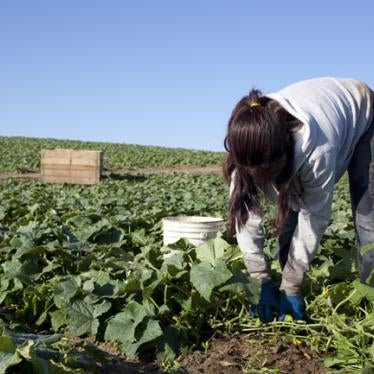In a Texas panhandle farming community, a mother—whose 11-year-old daughter toils in the cotton fields and cares for her younger brothers—tells her child, “I’m so sorry I stole your childhood from you.” While this mother may feel personally responsible, her government is also to blame.
Hundreds of thousands of children under the age of 18 work in agriculture in the United States. Under a clear double standard in U.S. federal law, children can toil in the fields at far younger ages, for far longer hours, and under far more hazardous conditions than children working any other type of employment in the United States. As they do so, child farmworkers risk their education, their health, and, sometimes, even their lives. This legal loophole also places the United States in violation of its international legal obligations.
Grueling, Dangerous, and Exploitative: Conditions for Young Workers in the Fields
In agriculture, children typically work what would be considered “adult hours” starting at the ages of 11 or 12. However, many begin to work part-time much earlier: Human Rights Watch has interviewed child farmworkers as young as seven. These children often work 10 or more hours a day: at the harvest peak they work daylight to dusk, up to seven days a week. Schoolchildren typically work weekends, summers, and before and after school. But migrant children often leave school before classes end for the summer in order to migrate, only to return weeks or months after classes begin.
Working long hours in high temperatures with sharp tools and heavy machinery, climbing up tall ladders, and lugging heavy sacks and buckets, children get hurt and sometimes they die. Agriculture is the most dangerous industry, in terms of fatalities, open to children, and more than half of all children who died from work-related injuries in 2010 worked in crop production.
Children are also exposed to pesticides, some directly, others through drift and residue. In addition to acute poisoning, long-term pesticide exposure is associated with cancer, brain damage, and reproductive problems. With their bodies still developing, children are especially at risk.
Farmworker women and girls are also exceptionally vulnerable to sexual abuse.
Legal Protection: Excluding Child Farmworkers
The U.S. Federal Fair Labor Standards Act, which governs child labor in the United States, provides no minimum age for children working on small farms with their parent’s permission. Children may work for hire on any farm with parental consent from age 12, and there are no legal limits on the hours children can work in agriculture outside of school. Children are also free to do agricultural work that the U.S. Department of Labor deems “particularly hazardous” for children at the of age 16 (and at any age on farms owned or operated by their parents).
By comparison, outside agriculture, children must be at least 16 to work, with a few exceptions: 14- and 15-year-olds can work in specified jobs, subject to restrictions, and for no more than three hours on a school day and eight hours on a non-school day. Children cannot do hazardous work until they reach age 18, even jobs such as driving a fork lift that they could do legally on a farm at 16. What is more, the Environmental Protection Agency (EPA) regulations, which govern the use and application of pesticides, make no special consideration for children.
Wages and the Poverty Cycle
Children working in agriculture typically make less than minimum wage, with their pay further cut when employers underreport hours and force the children to spend their own money on the tools, gloves, and drinking water that their employers should provide by law. Where pay is based on a piece rate, as is common in the fresh fruit and vegetable harvest, it is usually much worse.
With some exceptions, farmworkers—both child and adult—are legally entitled to minimum wage but employers often falsify payroll records to show fewer hours than the employee actually worked. Children may be even easier to exploit than adults if they are more credulous, less experienced, and less likely to question authority. They also may have even fewer options to change jobs, since their employment in other labor sectors may be illegal. Although employers who are required to pay minimum wage are also legally required to make up the difference when a worker does not pick enough on piece rate to earn minimum wage, none of the children Human Rights Watch interviewed said their employers had done so. When they do not, the piece rate system creates incentives for employers to allow young children to work, even if they earn very little. Moreover, when children work off the books and what they harvest is counted towards their parent’s check, this creates the appearance on paper that the adult has earned a higher wage.
Farmworkers are not entitled to overtime pay and rarely receive job-related benefits because of provisions in the Fair Labor Standards Act. Agricultural workers are also excluded from the protections of the National Labor Relations Act and do not have the right to organize and collectively bargain with their employers (except in the handful of states such as California in which state laws protect their right to organize). The laws denying overtime—combined with poor enforcement of existing minimum-wage laws—contribute to the financial desperation that compels children to work, and makes farmworkers even more vulnerable to exploitation. Poverty among farmworkers is more than double that of all wage and salary employees, and parents say they feel compelled to bring their children to work because they cannot afford child care, and they can benefit from the money their children’s hands can provide. That the work is legal also presents it as a legitimate choice for parents, children, and employers. However, the long hours and demands of farmwork result in high school drop-out rates that are four times the national average. Without a diploma, child workers are left with few options besides a lifetime of farmwork and the poverty that accompanies it.
Government Failure to Protect Children in Agriculture
Despite the damage to children’s health and education, in recent years enforcement of child labor laws by the Department of Labor’s Wage and Hour division has declined dramatically. This decline continued in 2010, despite the Department’s having added several hundred new labor inspectors and promised more robust enforcement. Agricultural inspections dropped by 9 percent from 2009 to 2010. While the total number of inspection hours in agriculture increased slightly, the increase was less than the proportional increase in inspectors.
In turn, child labor violations in agriculture decreased from 36 cases (involving 109 children) in 2009 to 31 cases (involving 49 children) in 2010, and overall civil monetary penalties assessed for child labor were almost halved. According to the Wage and Hour Division, this decline results from more effective enforcement strategies. While new strategies are important, this explanation is not supported by data, particularly in light of the decline in agricultural inspections.
On a more encouraging note, the Department in August 2011 proposed new rules to designate more agricultural tasks as hazardous and off limits to children under 16. If these become law, these would better protect younger teens.
International law agreed to by the United States demands more, from all parts of government. International Labor Organization Convention No. 182 on the Worst Forms of Child Labor prohibits children from engaging in dangerous or harmful work. The Convention on the Rights of the Child, to which the United States is a signatory but not a party, seeks to protect children from economic exploitation, and also from work that is hazardous. Because farmworker children are overwhelmingly ethnicly Hispanic, the disparity in legal protections provided to agricultural workers compared to other workers has a disparate impact that is discriminatory under international law.
What Should Be Done?
Congress should eliminate the double-standard in child labor laws and apply the same age and hour restrictions to children working in agriculture that already apply to other industries. At the same time, the Department of Labor should enforce the law, and the EPA should amend its standards to protect children. Until then, in America’s fields, children are indeed losing their childhoods.
*****
*****
Zama Coursen-Neff is the deputy director of Human Rights Watch’s Children’s Rights Division and the author of Fields of Peril: Child Labor in US Agriculture.








